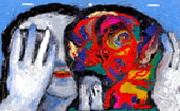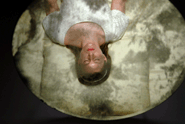 Brave Men, 2008. In its tale of childhood friends who grow up to be on opposite sides of the law, Edoardo Winspeare’s Brave Men is an all too familiar one. A prominent judge, Ignazio (Fabrizio Gifuni) returns to his hometown to bury his friend Fabio (Lamberto Probo) who died from a drug overdose, and, in an attempt to draw something constructive from the painful episode, joins a task force that is investigating local drug traffickers who helped feed his self-destructive habit. His immediate connection with the past is mutual friend, Lucia (Donatella Finocchiaro), an attractive, single mother whose seemingly strained relationship with her former lover, a local mobster named Infantino (Beppe Fiorello) makes her an obvious choice to mine for information. From the onset, Lucia proves to be far from the upstanding perfume salesperson she seems, using her nefarious connections to try to root out Fabio’s supplier and intimidating rival gangs into forging an alliance with elusive crime boss, Carmine Zà (Giorgio Colangeli). But as the investigation converges towards Lucia’s complicity in the escalating mob war, Ignazio is also forced to reconcile his own unrequited feelings towards her, only to lose his objectivity and sense of moral duty in the process. Actress Donatella Finocchiaro commented during the Q&A that the film strives to capture the drug war climate of the late 1980s Italy when low level criminals started forming alliances among themselves to consolidate their power as a means of challenging established organizations. However, far from insightful commentary into the psychology and mechanics of gangland power play, the film devolves into facile characterizations, glossing over deeply rooted socioeconomic issues (alluded in the disparity between Ignazio’s privileged upbringing and Lucia’s poverty that would separate them) in favor of a conventional mood piece on loss, fear, and desire.
Brave Men, 2008. In its tale of childhood friends who grow up to be on opposite sides of the law, Edoardo Winspeare’s Brave Men is an all too familiar one. A prominent judge, Ignazio (Fabrizio Gifuni) returns to his hometown to bury his friend Fabio (Lamberto Probo) who died from a drug overdose, and, in an attempt to draw something constructive from the painful episode, joins a task force that is investigating local drug traffickers who helped feed his self-destructive habit. His immediate connection with the past is mutual friend, Lucia (Donatella Finocchiaro), an attractive, single mother whose seemingly strained relationship with her former lover, a local mobster named Infantino (Beppe Fiorello) makes her an obvious choice to mine for information. From the onset, Lucia proves to be far from the upstanding perfume salesperson she seems, using her nefarious connections to try to root out Fabio’s supplier and intimidating rival gangs into forging an alliance with elusive crime boss, Carmine Zà (Giorgio Colangeli). But as the investigation converges towards Lucia’s complicity in the escalating mob war, Ignazio is also forced to reconcile his own unrequited feelings towards her, only to lose his objectivity and sense of moral duty in the process. Actress Donatella Finocchiaro commented during the Q&A that the film strives to capture the drug war climate of the late 1980s Italy when low level criminals started forming alliances among themselves to consolidate their power as a means of challenging established organizations. However, far from insightful commentary into the psychology and mechanics of gangland power play, the film devolves into facile characterizations, glossing over deeply rooted socioeconomic issues (alluded in the disparity between Ignazio’s privileged upbringing and Lucia’s poverty that would separate them) in favor of a conventional mood piece on loss, fear, and desire.
*****
Animated Passions: The Films of Ursula Ferrara
 During the Q&A for the screening of Animated Passions: The Films of Ursula Ferrara, Ferrara commented that her body of work reflects the conventional progression of her formal art school training, graduating from monochrome to color, simple sketches to more complex forms. The theme of evolution and transformation is also integrally connected to the metaphorical image of natural evolution in her early pencil drawing films, Lucidi Folli (Lucid Insanity, 1986) and Past Future (Congiuntivo futuro, 1988) – a penchant for metamorphosis that Ferrara describes as a logical way to represent the subconscious creative process. Playful and singular, these early films reflect youthful exuberance and irreverence in their organic illustrations of recurring life cycles – love, work, leisure, sexuality, and reproduction (the image of an infant in Lucidi Folli and an egg in Past Future) – that unfold against the familiar rhythms of everyday life (as symbolized by the incorporation of contemporary pop music).
During the Q&A for the screening of Animated Passions: The Films of Ursula Ferrara, Ferrara commented that her body of work reflects the conventional progression of her formal art school training, graduating from monochrome to color, simple sketches to more complex forms. The theme of evolution and transformation is also integrally connected to the metaphorical image of natural evolution in her early pencil drawing films, Lucidi Folli (Lucid Insanity, 1986) and Past Future (Congiuntivo futuro, 1988) – a penchant for metamorphosis that Ferrara describes as a logical way to represent the subconscious creative process. Playful and singular, these early films reflect youthful exuberance and irreverence in their organic illustrations of recurring life cycles – love, work, leisure, sexuality, and reproduction (the image of an infant in Lucidi Folli and an egg in Past Future) – that unfold against the familiar rhythms of everyday life (as symbolized by the incorporation of contemporary pop music).
Asymmetrical Feel (Amore asimetrico, 1990) and As People (Come persone, 1995) reflect a newfound maturity, distance, and restlessness in Ferrara’s work. Vacillating between disparate modern art forms, in particular, cubism and graphic arts, Ferrara abandons the simple, flat space, line drawings of her early films to create more voluptuous and geometric forms. It is interesting to note that in the use of a violin adaptation of Recuerdos de Alhambra (traditionally, a guitar piece) in As People in lieu of seemingly random pop music that had accompanied her early films, Ferrara incorporates a more deliberate, tensile dimension to her work in this period, supplanting the brashness of her earlier films with a more introspective tone.
Almost Nothing (Quasi niente, 1997) represents Ferrara’s adoption of oil paints on film, marking a transition from black and white to color, and also from singular lines to filled spaces. The shift towards volume, gradation, and texture is also reflected in Five Rooms (Cinque stanze, 1999) and The Match (La partita, 2002), where dimensionality is created through isolated framing that compartmentalize movement within the context of larger, overarching spaces (a house floor plan in Five Rooms, and spectators and players in The Match). Ferrara further experiments with faceting and layered compositions in her collage approach to the most recent film in the program, News (2006). Intriguingly, Ferrara’s mixed media approach to News is also an integration of old (paper) and new (cel), combining found object (newspaper clippings) with hand-painted illustrations that insightfully convey the complex issues behind terse, often sensationalized newspaper headlines.
*****
 The Sicilian Girl, 2009. Marco Amenta’s potent, yet understated, tightly crafted first feature film is a fictionalized account loosely based on the life and journals of Rita Atria, the determined, 17 year old daughter of a slain mob boss whose death after her denunciation of the mafia would lead to her martyrdom as a symbol of the country’s ongoing war with organized crime. Interweaving the detailed observation of a court procedural with the drama and intrigue of a genre crime film, the convergence of fiction and reality becomes a metaphor for the heroine’s (also named Rita) metamorphosis from self-involved girl to social activist. Having once lived a seemingly idyllic life of privilege and respect as the coddled daughter of a well-connected, old world mafioso, Don Michele (Marcello Mazzarella), Rita’s teenaged years would be consumed with the thought of avenging her father’s death when he is gunned down in a public square at the orders of rival Don Salvo (Mario Pupella) during a power struggle to expand their reach into the drug trade. But when Rita’s older brother (Carmelo Galati) is also slain when the all-too-connected Don Salvio is tipped off about his plans for retribution, Rita turns to a thoughtful, hard-nosed prosecutor (Gérard Jugnot) for help – a character based on magistrate Paolo Borsellino – lodging a full-scale indictment of Don Salvo’s wide-reaching organization with the help of Rita’s meticulously detailed, years-long surveillance diaries of their operations. Illustrating the ingrained culture of regional disparity, chauvinism, corruption, and disenfranchisement, Amenta underscores fundamental social issues between Roman central authority and the local Sicilian population that contribute to the deep-seated friction and enable the broad reach of the mafia and its own inviolable codes. Also worth noting is lead actress Veronica D’Agostino’s compelling performance, navigating the complex trajectory of Rita’s tragic life from headstrong daughter, to obsessed avenger, to passive victim, and finally, to altruistic crusader.
The Sicilian Girl, 2009. Marco Amenta’s potent, yet understated, tightly crafted first feature film is a fictionalized account loosely based on the life and journals of Rita Atria, the determined, 17 year old daughter of a slain mob boss whose death after her denunciation of the mafia would lead to her martyrdom as a symbol of the country’s ongoing war with organized crime. Interweaving the detailed observation of a court procedural with the drama and intrigue of a genre crime film, the convergence of fiction and reality becomes a metaphor for the heroine’s (also named Rita) metamorphosis from self-involved girl to social activist. Having once lived a seemingly idyllic life of privilege and respect as the coddled daughter of a well-connected, old world mafioso, Don Michele (Marcello Mazzarella), Rita’s teenaged years would be consumed with the thought of avenging her father’s death when he is gunned down in a public square at the orders of rival Don Salvo (Mario Pupella) during a power struggle to expand their reach into the drug trade. But when Rita’s older brother (Carmelo Galati) is also slain when the all-too-connected Don Salvio is tipped off about his plans for retribution, Rita turns to a thoughtful, hard-nosed prosecutor (Gérard Jugnot) for help – a character based on magistrate Paolo Borsellino – lodging a full-scale indictment of Don Salvo’s wide-reaching organization with the help of Rita’s meticulously detailed, years-long surveillance diaries of their operations. Illustrating the ingrained culture of regional disparity, chauvinism, corruption, and disenfranchisement, Amenta underscores fundamental social issues between Roman central authority and the local Sicilian population that contribute to the deep-seated friction and enable the broad reach of the mafia and its own inviolable codes. Also worth noting is lead actress Veronica D’Agostino’s compelling performance, navigating the complex trajectory of Rita’s tragic life from headstrong daughter, to obsessed avenger, to passive victim, and finally, to altruistic crusader.
 I Am Alive, 2008. Vacillating between opaque social commentary on the inequity of conditional employment and idiosyncratic dark comedy, screenwriters Dino Gentili and Filippo Gentili’s directorial debut chronicles a day in the life of underemployed day laborer, Rocco (Massimo De Santis) who, faced with a stack of unpaid bills and mounting debt from his girlfriend’s free-spending habits, agrees to take on an odd job from a disreputable businessman, Marco Resti (Giorgio Colangeli) to watch over his recently deceased daughter’s body for the night in the empty family villa – having purportedly succumbed to a long illness earlier that day – while he makes arrangements for her funeral in the morning. At first, the film hews towards neorealism in Rocco’s seeming redemption through work, evolving from desperate (and implicitly suicidal), unemployed worker to one determined to fulfill his obligatory vigil at all cost, making scattered home repairs to help pass the idle hours. However, the parade of eccentric visitors soon neuters the tone to something more akin to a comedy of errors – an unreliable co-worker, Gianni (Marcello Mazzarella) who leaves his post to go carousing, a playboy son, Adriano (Guido Caprino) who takes advantage of his father’s absence to bring his friends home for a drug-fueled party, a former gardener, Vlad (Vlad Alexandru Toma) who has returned in order to force a resolution to the long-standing feud with his erstwhile employer – creating an uncohesive, all-encompassing slice-of-life portrait that, like its aimless protagonist, seems destined to sink in the gravity of self-inflicted, assumed roles, foundering without direction.
I Am Alive, 2008. Vacillating between opaque social commentary on the inequity of conditional employment and idiosyncratic dark comedy, screenwriters Dino Gentili and Filippo Gentili’s directorial debut chronicles a day in the life of underemployed day laborer, Rocco (Massimo De Santis) who, faced with a stack of unpaid bills and mounting debt from his girlfriend’s free-spending habits, agrees to take on an odd job from a disreputable businessman, Marco Resti (Giorgio Colangeli) to watch over his recently deceased daughter’s body for the night in the empty family villa – having purportedly succumbed to a long illness earlier that day – while he makes arrangements for her funeral in the morning. At first, the film hews towards neorealism in Rocco’s seeming redemption through work, evolving from desperate (and implicitly suicidal), unemployed worker to one determined to fulfill his obligatory vigil at all cost, making scattered home repairs to help pass the idle hours. However, the parade of eccentric visitors soon neuters the tone to something more akin to a comedy of errors – an unreliable co-worker, Gianni (Marcello Mazzarella) who leaves his post to go carousing, a playboy son, Adriano (Guido Caprino) who takes advantage of his father’s absence to bring his friends home for a drug-fueled party, a former gardener, Vlad (Vlad Alexandru Toma) who has returned in order to force a resolution to the long-standing feud with his erstwhile employer – creating an uncohesive, all-encompassing slice-of-life portrait that, like its aimless protagonist, seems destined to sink in the gravity of self-inflicted, assumed roles, foundering without direction.
Acquarello, 2009 [reprinted]